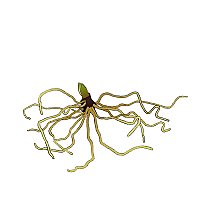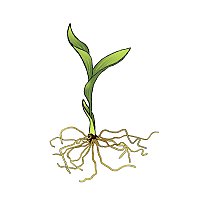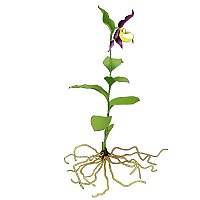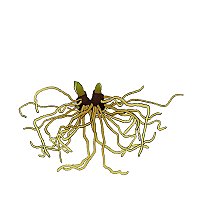Cypripedium hybrides
Growth Phase
The new Cypripedium shoots usually appear during April; except for Cypripedium formosanum, more precocious, which often emerge at the beginning of March, and Cypripedium reginae, which emerge later. Once started, the vegetation grows very quickly; in 3 to 5 weeks, the foliage has opened out. The flowering extends from the end of April to the beginning of June. At the end of the summer, the foliage yellows then fades before disappearing completely. Cypripedium then go into their winter dormancy. When the leaves have completely faded, the stems can be cut, preserving a height of 5cm. Take care not to damage any possible new shoots that are already present.
Over the years and following the successive growth and dormancy cycles, Cypripedium not only become stronger but also multiply, thanks to the annual appearance of new shoots.
Winter Dormancy
Cypripedium are the hardy orchids that are the most resistant to cold. The majority of the species, except Cypripedium formosanum, franchetti, and japonicum, fearlessly withstand temperatures below -30°C, -40°C.
During the winter, the plant persists in rhizome form and does not require any special protection.
Planting
Cypripedium are the most demanding garden orchids as far as their substrate is concerned. If your soil is too compact or contains too much clay, we would advise you to create a planting pocket. Dig a trough of approximately 40cm, cover the bottom of it with a drainage layer (lava stones or small pebbles) and fill it with the substrate recommended above.
Cypripedium prefer soil that is low in organic matter and has good draining properties. Airing the soil is recommended, using a mineral substrate (at least 50%) such as sand, Argex, pearlstone or ideally lava stone (vulca). As organic matter, you can add a little finely crushed pine bark, or some compost based on coconut leaves or fibres.
It is important not only that the rhizomes of the Cypripedium do not desiccate in summer but also that they are not immersed in winter. The various mineral substrates will ensure good moisture retention in summer while encouraging good drainage during the winter.
For an optimal result, we would recommend PHYTESIA compost (a pre-prepared mixture of peat, lava stone and bark chippings), which is specific for garden orchids.
Exposure
In the garden, we recommend planting Cypripedium in a cool, shaded or semi-shaded place. Sunlight at the hottest hours of the day is to be avoided.
Fertilisation and Pesticide Treatments
Cypripedium have little appreciation of fertilisers. You can however use (with moderation) some slow-release manure such as Osmocote. This can be applied in the spring when the germs start to emerge from the soil.
If your garden is frequently invaded by slugs, we strongly recommend the use of anti-slug products, at least during the emergence of the new shoots in spring. Indeed, the young Cypripedium germs are particularly attractive for those pests.



